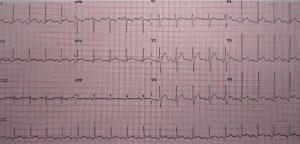
Pericarditis
Introduction Pericarditis is a common cause of chest pain, and may mimic the signs and symptoms of myocardial infarction. It is a result of inflammation of the pericardium. The two most…

Introduction Pericarditis is a common cause of chest pain, and may mimic the signs and symptoms of myocardial infarction. It is a result of inflammation of the pericardium. The two most…
Fetal circulation The fetus receives blood via the umbilical vein. Once this enters the body, it travels through the liver as the ductus venosus before joining the inferior vena cava.…
The physics Flow = pressure difference / resistance Thus, the two main factors in determining flow are pressure within a vessel, and the resistance of a vessel. Velocity The velocity…
Postural hypotension is a transient fall in blood pressure which causes symptoms when a patient moves from sitting or lying to standing. Physiology Moment to moment, blood pressure is controlled…
Introduction Premature Ventricular Complexes - PVCs (aka ventricular ectopic beats - VEBs) are a common, and usually (but not always) benign cardiac rhythm abnormality. PVCs may present with palpitations, although…
Overview Rheumatic heart disease (RHD) is a a chronic condition caused by irreversible damage to the heart as a result of rheumatic fever. Rheumatic fever is an auto-immune mediated condition…
Introduction Stable angina (aka Angina Pectoris) is a common presentation of Coronary Heart disease - CHD(aka Ischaemic Heart disease - IHD) Stable angina, (aka ‘Angina pectoris’, and colloquially "Angina") is a syndrome…
This summary of ECG abnormalities is part of the almostadoctor ECG series. For a more in depth explanation of ECG abnormalities, see ECG abnormalities. To learn about the basic principle of…
The term Supraventricular Tachycardia can be used to refer to any tachycardia arising from above the bundle of His, although in clinical practice it usually refers to an AV node…

Introduction Tetralogy of Fallot – R-to-L shunt – CYANOTIC THE most common cause of cyanotic heart disease – but only accounts for <10% of all congenital cardiac abnormalities Has four…